An Advanced Driver Assistance System (ADAS), also referred to as a Collision Warning System (CWS), refers to a broad group of safety systems that improve driving safety by tackling human error, a leading cause of vehicle accidents.
ADAS systems have been featured on Singapore buses since 2014. While earlier adopted ADAS systems were standalone alert systems, newer buses also feature 360-degree camera-based systems.
Functionality
On Singapore buses, ADAS systems are non-intervening, i.e. they only provide audio/visual alerts to the driver, and do not take over control of the vehicle in any way. These ADAS systems typically offer the following functionalities:
- Pedestrian & vehicle proximity alerts
- Headway distance monitoring
- Speed limit indicator
- Lane departure warning
- Blind-spot monitoring
Different ADAS systems offer different degrees of functionality, and some are bundled with telematics capabilities as well. The most common models are varieties offered by Streamex (distributed by TNT Surveillance), Mobileye, ST Engineering, and Continental Automotive. Since 2022, 360-degree camera-based systems that fulfil all the above functionalities have also been adopted.
LTA Requirements
Under the Bus Contracting Model (BCM), the Land Transport Authority (LTA) is responsible for the procurement of buses and their specifications. While several types of ADAS systems have been trialled in the mid-2010s, the LTA made ADAS a mandatory requirement for buses procured starting in late 2017. Both the LTA and individual bus operators have also retrofitted ADAS systems to existing buses since the late 2010s and early 2020s.
In the Committee of Supply Debate 2025, the Government accepted the recommendations of the Bus Safety Tripartite Taskforce to improve safety practices for the public bus sector, reinforcing the desire to expend the use of ADAS systems on buses. In particular, the Taskforce recommends equipping the entire bus fleet with 360-degree collision warning systems, and enhanced with artificial intelligence for collision alerts.
Related Systems
- Anti-Fatigue Systems, which detect and counter driver fatigue
- Camera mirror systems, which are digital replacements for traditional side mirrors
These systems are covered in a separate article.
ADAS Systems
SBS Transit was the first Public Transport Operator (PTO) to introduce ADAS systems on its fleet in November 2014. Following a small-scale trial of the Mobileye 560 installed on 30 buses, SBS Transit would later embrace the technology and equip its entire fleet of more than 3,500 buses by 2019.
Basic ADAS models (e.g. Mobileye 560/630, TNT Surveillance T-DA) comprised a front-facing camera unit coupled with a small dashboard display unit that displayed vehicle/pedestrian proximity alerts and lane departure warnings, with corresponding audio alerts. Later, additional cameras and display units were fitted for side blindspot monitoring (e.g. Mobileye Shield+, TNT Surveillance T-SA), and some models integrated these individual dashboard displays into a larger monitor (e.g. ST Engineering Drivesafe).
It is believed that the merits of the technology were accepted by the LTA and eventually adopted into its requirements for its bus procurement. Under the Bus Contracting Model (BCM), buses procured by LTA since late 2017 are fitted with ADAS systems. By bundling ADAS systems with LTA-owned buses, these systems are now LTA-owned, providing opportunities for standardisation between bus operators, easing driver familiarity, and facilitating system maintenance.
On top of supplying ADAS systems to new buses, PTOs have also retrofitted ADAS systems to their existing buses during BCM tendered contract terms, such as SBS Transit during the Seletar and Bukit Merah bus package (first terms), and Tower Transit which installed 360-degree camera systems on all Sembawang–Yishun Bus Package buses. Since these buses are assets leased from the LTA, it is not yet known if operator-retrofitted ADAS systems would be uninstalled or reimbursed when ownership of buses is transferred between LTA/operators, if any.
ADAS Systems in use
1. Mobileye 560 / Mobileye 630
Mobileye 560 / Mobileye 630
| Model | Mobileye 560 (older) / Mobileye 630 (newer) |
| Functionality | Headway measurement, Pedestrian & Vehicle collision alert, Lane Departure Warning Speed limit alert (Mobileye 630 only) |
| Buses | Most SBS Transit Buses, SMRT Training Buses, some Go-Ahead Singapore buses, SG5999Z, SG4002G |
The Mobileye 560 and Mobileye 630 Advanced Driver Assistance System (ADAS) alerts drivers to vehicles, pedestrians and cyclists on the roads, while also featuring a lane departure warning. It is the basic Mobileye system installed across many buses. In addition, the system offers Fleet Management System (FMS) integration allowing for Intelligent Event Data Recording (EDR), and connectivity abilities with other external devices using Bluetooth wireless technology.
The system comprises a windshield-mounted Vision Sensor Unit (containing a camera and an image processor), a buzzer and a dashboard-mounted EyeWatch Display Unit for visual directional warnings and numerical headway measurement display.
The newer Mobileye 630 offers similar functionalities but elements on the Display Unit are indicated differently.
In a May 2016 press release, SBS Transit announced that 750 buses would be installed with the Mobileye 560 system by that year, and more than 3,000 buses would be equipped with it by the end of 2018, with the eventual goal of fleet-wide implementation. Starting from 2018, a newer model (Mobileye 630) was installed instead of the Mobileye 560.
Background Data collection
In addition to real-time alerts presented to BCs, the Mobileye system also records additional parameters that are logged and uploaded to a cloud server. This enables SBS Transit to monitor every instance of dangerous driving behaviour across all buses installed with the system. As such, Mobileye also functions as a telematics system.
Main Article: Mobileye collision alert system
2. Mobileye Shield+
Mobileye Shield+
| Model | Mobileye Shield+ |
| Functionality | Pedestrian & Vehicle sideswipe collision alert (As an add-on to the Mobileye 560 / 630) |
| Buses | Volvo B5LH, Volvo B8L, MAN A95 3-Door Concept Bus (SG5999Z) Small number of SBS Transit buses: Mercedes-Benz Citaro, Volvo B9TL, Scania K230UB |
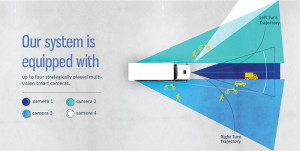
The Mobileye Shield+ Collision Avoidance System is an improvement of the existing Mobileye 560 and Mobileye 630, with two additional cameras installed at the rear of the bus. Covering both the left and right sides of the vehicle, drivers are alerted to cyclists, pedestrians and motorcyclists within their blind spot while making a turn. These are connected to two additional large-sized display units mounted near the left and right rearview mirrors, easily seen by Bus Captains when they glance at their mirrors.
The Mobileye 560 as described in the above section is also a part of the Mobileye Shield+ system. Using a windscreen-mounted camera and dashboard display unit, it alerts drivers to vehicles, pedestrians and cyclists on the roads, while also featuring a lane departure warning. As such, the Mobileye Shield+ system utilises a total of 3 cameras.
The system was first installed on an SBS Transit Mercedes-Benz Citaro (SBS6650K) in January 2017 for a six-month trial and has since been installed on SG4003D and SG5999Z.
The Mobileye 560, Mobileye 630 and Mobileye Shield+ systems are developed by Mobileye, an Israeli technology company founded in 1999.
Main Article: Mobileye collision alert system
3. ST Engineering DriveSafe
ST Engineering DriveSafe Intelligent Warning System
| Model | ST Engineering DriveSafe Intelligent Warning System |
| Functionality | Pedestrian & Vehicle collision alert (all sides), blinker lights and buzzers, overhead collision alert (formerly) |
| Buses | MAN A22, MAN A95, Linkker LM312 |
The DriveSafe system by ST Engineering (formerly known as the Integrated Smart Advanced Warning Unit, or I-SAW-U) comprises four camera sensors and two ultrasonic sensors. When a vehicle, cyclist or pedestrian approaches the bus, the camera sensors detect them as obstacles. An alarm will sound and the location of the obstacle will be displayed visually on a new screen installed in the Driver’s Cockpit. DriveSafe also provides alerts if the bus is travelling too close to a vehicle in front, if a pedestrian steps in front of the bus, or if the bus captain strays off his lane.
The screen reflects two levels of alerts based on the proximity of the obstacle: an amber alert when the obstacle is 1m away, and a red alert when the obstacle is between 0.5m to 0.8m away from the bus. These thresholds can be redefined in the future. In addition, the two ultrasonic sensors mounted on the roof of the bus are able to detect and warn drivers if they are about to hit an overhead obstacle (this feature was later removed).
Finally, DriveSafe also comes with additional features, such as blinker lights and buzzers mounted outside the bus, which can alert other road users, such as cyclists, if they are riding too close to the buses. These will be activated later during the trial.
An initial six-month trial was conducted in April 2018, with 20 public buses being equipped with the system, namely MAN A22 (SBS Transit & Tower Transit – 5 units each), and MAN A95 (SMRT & Go-Ahead – 5 units each).
Production batch Euro 6 MAN A22 and MAN A95 buses also received the system.
Main Article: ST Engineering DriveSafe Intelligent Warning System
4. TNT Surveillance T-FA / T-SA
TNT Surveillance T-FA Front Alert Camera & T-SA Side Alert Camera
| Model | T-FA Front Alert Camera | T-SA Side Alert Camera |
| Functionality | T-FA Front Alert Camera: Lane departure warning system, forward collision warning, distance monitoring & pedestrian detection T-SA Side Alert Camera: Side blind spot detection for pedestrians or cyclists |
| Buses | New: BYD K9, Yutong E12, Yutong E12DD, Mercedes-Benz Citaro hybrid, Alexander Dennis Enviro500 (3 Door) Retrofitted: MAN A22 (Euro V / Euro VI); MAN A95 (Euro VI), ADL Enviro500, Volvo B9TL (Wright), Mercedes-Benz Citaro |
The T-FA Front Alert Camera is a windscreen-mounted camera connected to a dashboard display unit (T-Watch). It alerts drivers to vehicles, pedestrians and cyclists in front of the bus, while also offering lane departure warning.
The T-SA Side Alert Cameras are installed at the rear of the bus, connected to a dashboard display unit (T-Watch). Covering both the left and right sides of the vehicle, drivers are alerted to cyclists, pedestrians and motorcyclists within their blind spot while making a turn.
Both the T-FA Front Alert Camera and T-SA Side Alert Camera belong to the TNT Surveillance T-Guard Driver Management System. Other tools offered as part of T-Guard include an Anti-Fatigue System (T-DA), a telematics system (T-SEEDS) and a fleet management dashboard.
TNT Surveillance Social Media:
Radar sensor integration
Some buses integrate an AI radar sensor that detect objects entering a bus’ blind spot.
5. MooVita Advanced Driver Assistance System
MooVita Advanced Driver Assistance System
| Model | MooVita Advanced Driver Assistance System |
| Functionality | TBC |
| Buses | MAN A22 (Euro V); MAN A24 |
Largely found retrofitted to SMRT buses. Full functionality TBC.
6. Continental Automotive (trial model)
Continental Automotive Camera System (Model Unknown)
| Model | Unknown |
| Functionality | Unknown |
| Buses | SG5012X (Tower Transit Volvo B9TL, trial) |
7. Agil DriveSafe+
Agil DriveSafe+
Agil DriveSafe+ is a camera-based 360-degree collision warning system; an upgrade over the older ST Engineering Drivesafe system rolled out in 2018. Four wide-angle cameras around the bus detect pedestrians/cyclists or vehicles and deliver audio and visual alerts to the Bus Captain via a small driver display unit and dashboard-mounted speaker.
According to press reports, the system can also differentiate between roads and pavements through machine learning, thus separating a pedestrian on the road who may be in danger of being hit from one waiting at a bus stop. This prevents false alerts to the bus driver, which can cause further distractions.
Road users are also alerted via a blinker and buzzer on the side of the bus if they come within 4.3m of the bus. The alerts will sound only if the bus is moving.
The alerts will sound only if the bus is moving.
SBST installed the system on 27 buses as part of a six-month pilot by the bus operator and ST Engineering. The buses are deployed on bus services 29, 40, 81 and 137.
| Model | AGIL DriveSafe+ |
| Functionality | 360-degree collision warning system Headway monitoring, forward collision warning, lane departure warning, blind spot detection for pedestrians/cyclists/vehicles, exterior LED blinkers |
| Buses | Several SBS Transit buses |
360-degree Surround View Camera systems in use
Sometime in 2022, Surround View Camera Systems gained prevalence, with both new and retrofitted buses receiving the system. On top of the existing collision and blind spot monitoring alert features offered by other ADAS systems, these systems use a set of externally mounted cameras around the bus (at least 4) to generate a top-down image in real-time, which is fed to a driver display monitor.
Surround view camera systems further improve blind spot monitoring over other ADAS models and different viewing angles can also be generated (e.g. the TNT Surveillance model pivots the viewing angle to prioritise the left or right side blindspot depending on which blinkers are activated). During the transition, some buses had surround-view camera systems fitted in addition to non-surround-view ADAS models, but newer buses have been exclusively fitted with surround-view cameras.
1. TNT Surveillance T-A.I. 360°
TNT Surveillance T-A.I. 360° Surround View Camera System
| Model | TNT Surveillance T-A.I. 360° |
| Functionality | Real-time Surround View Camera System – Display unit with Proximity alert |
| Buses | Tower Transit buses under the Sembawang–Yishun Bus Package: (BYD C6, MAN A22 (Euro V), MAN A22 (Euro VI), Mercedes-Benz OC500LE, Volvo B5LH, Alexander Dennis Enviro500, Alexander Dennis Enviro500 (3 Door), MAN A95 (Euro V), MAN A95 (Euro VI), MAN A24 |
Footage from four cameras mounted on the bus (front, rear, left and right sides) are composed to form a top-down view of the vehicle in real-time. The system enhances the driver’s situational awareness on the roads and assists with blindspot monitoring. The display screen is typically mounted in the centre of the dashboard, but some vehicles have the screen mounted on the top of the driver’s cab (e.g. Mercedes-Benz OC500LE).
When the left or right blinkers are activated, the camera view pans in the same direction (see above image) for enhanced blindspot monitoring.
The display screen can be alternatively configured to show a live feed of any one of the cameras, with some buses observed to be displaying a feed of just the front or rear view camera.
TNT Surveillance Social Media:
2. Continental ProViu ASL360
Continental Automotive ProViu ASL360 Surround View Camera System
| Model | Continental Automotive ProViu ASL360 |
| Functionality | Real-time display with Proximity alert |
| Buses | 3-door MAN Lion’s City SD (SG4002G), SBS3337K (Tower Transit Volvo B9TL, trial) |
Four cameras mounted on the bus (front, rear, left and right sides) generate a top-down view of the vehicle in real-time, with visual and audio alerts if the bus approaches too close to other road objects. The system enhances the driver’s situational awareness on the roads and assists with blindspot monitoring.
See also: Anti-Fatigue Systems, Camera Mirror Systems
External Links & References:
- —
Back to Buses
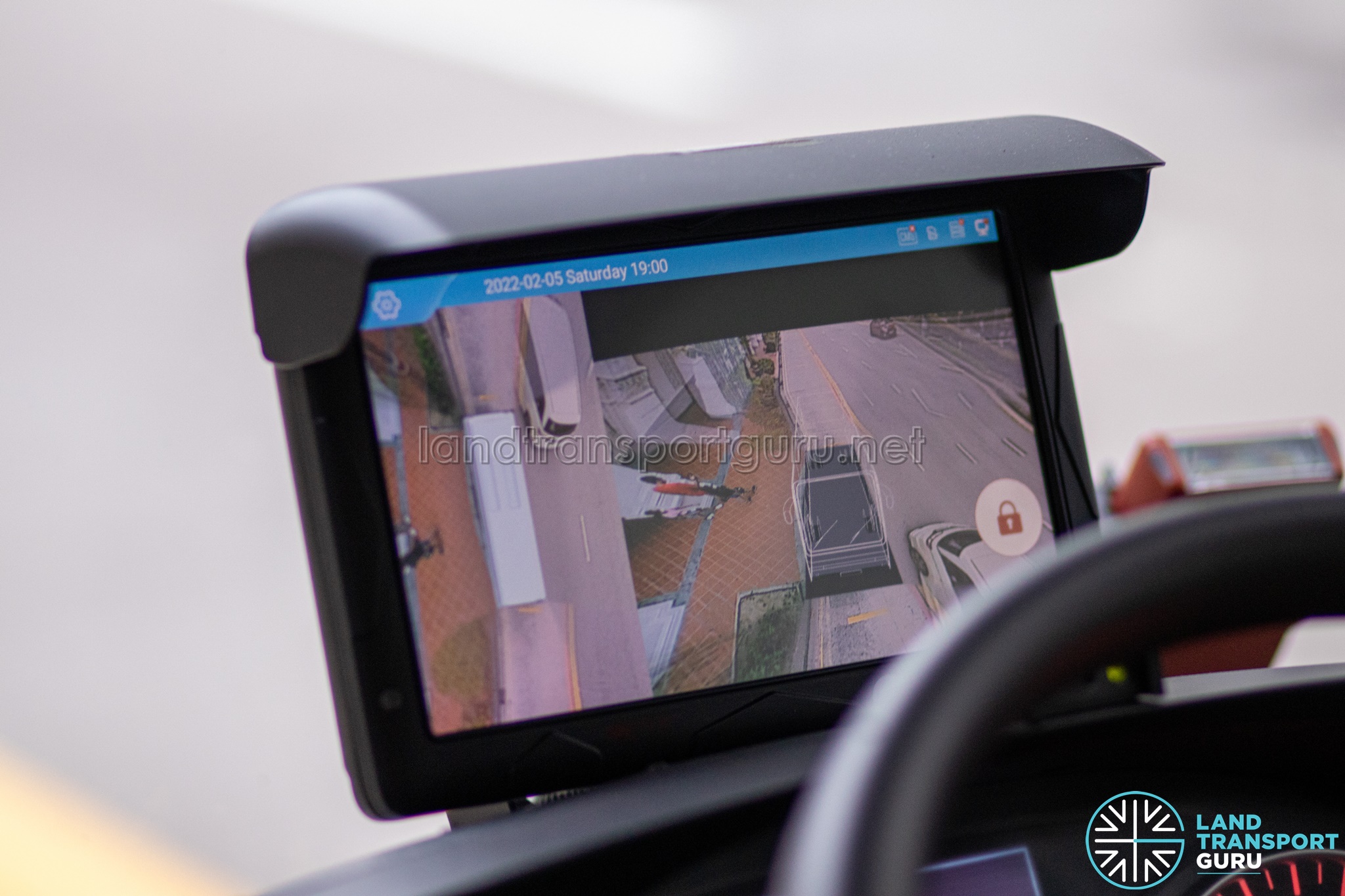
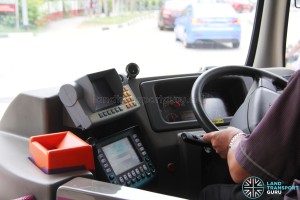
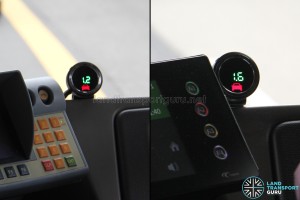
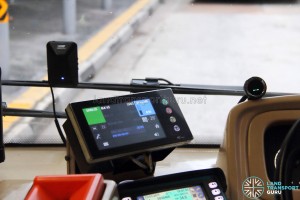
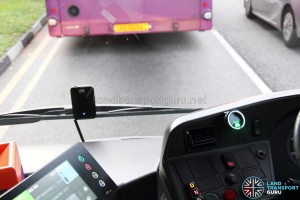
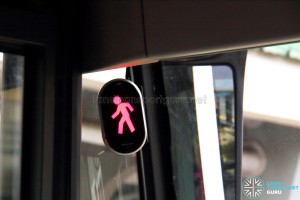
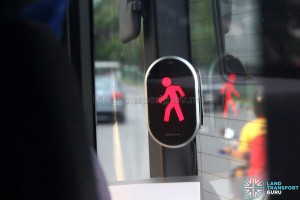
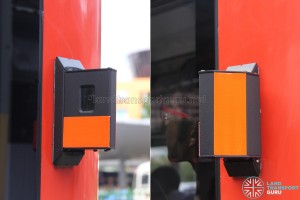
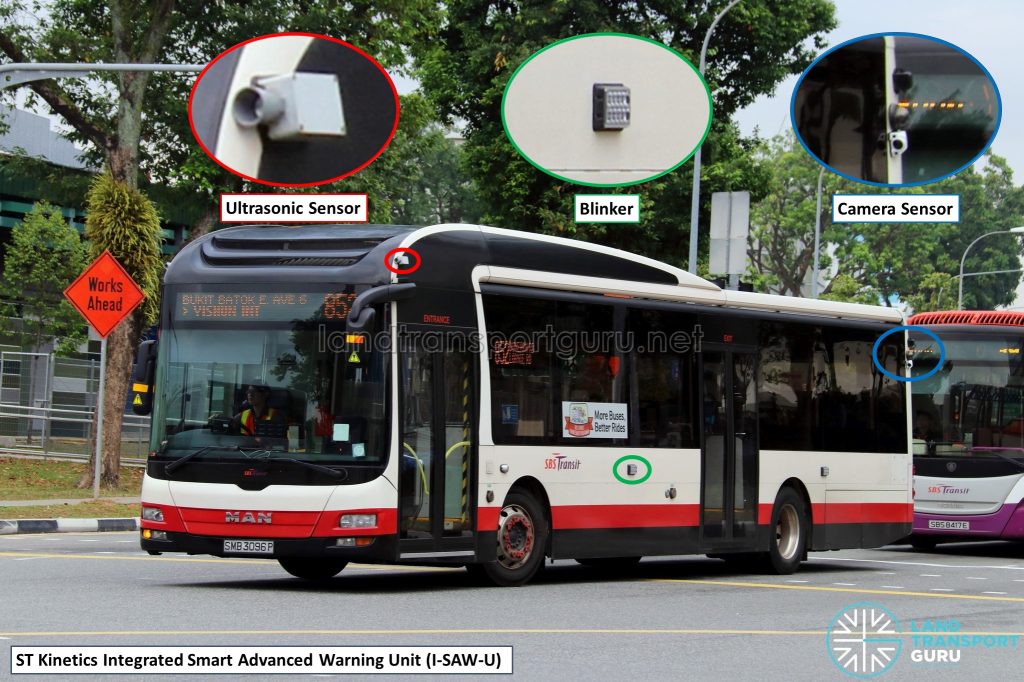
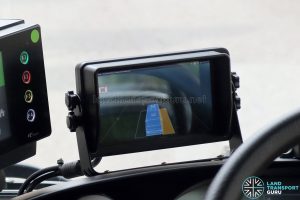
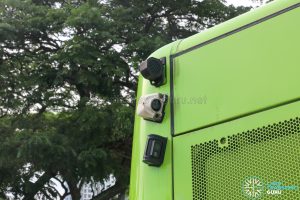
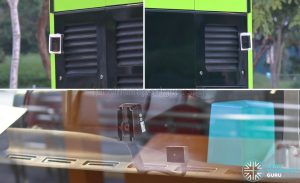
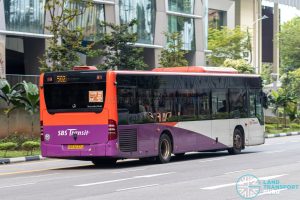
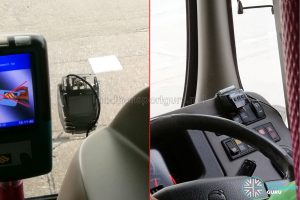
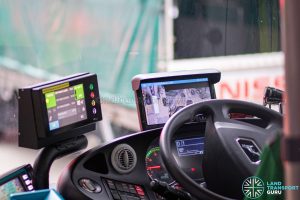
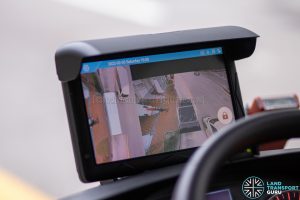
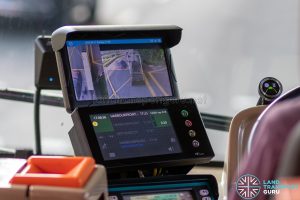
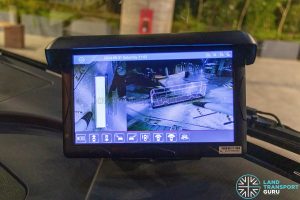

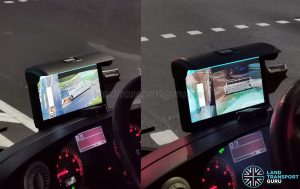
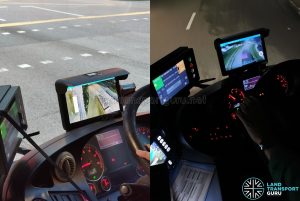
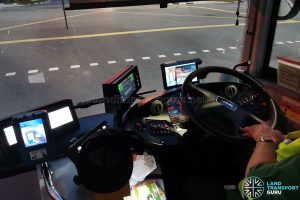
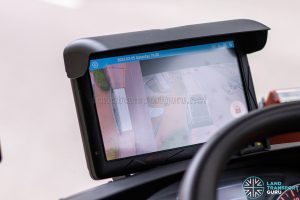
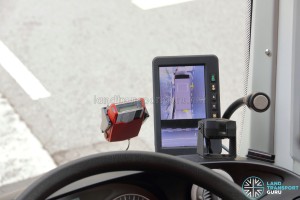
Everytime, I take any Single Decker Bus have Mobileye Installed, I always can’t sit Infornt?
Very Irritating with these Noisy Mobileye installed on SBST Single Deck Buses?
something new is installed on SG5012X, unsure of model but it is an ADAS